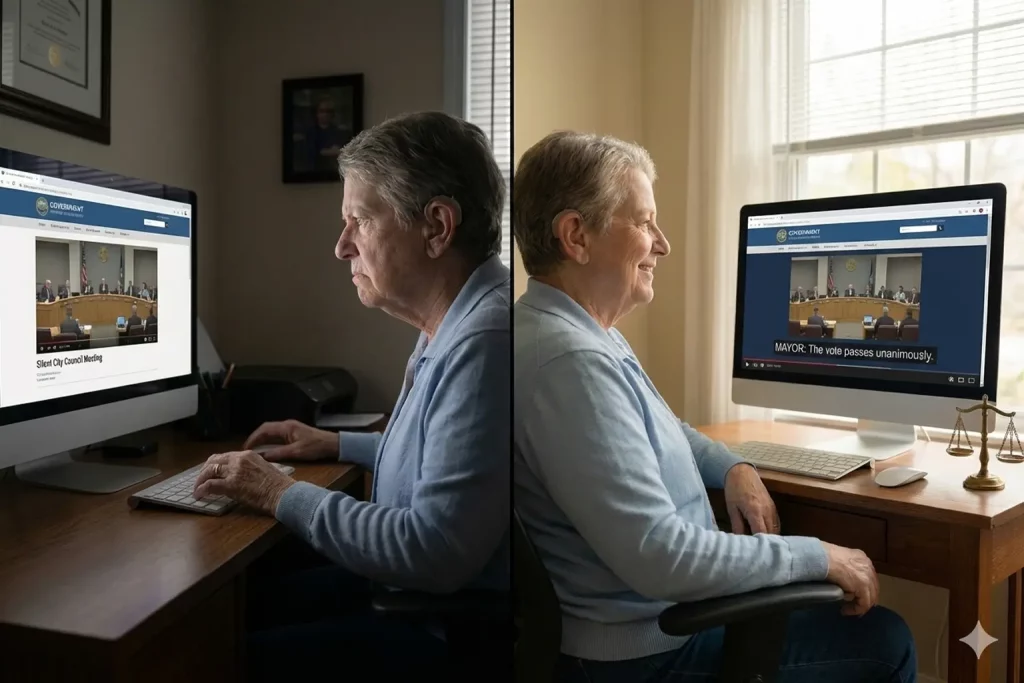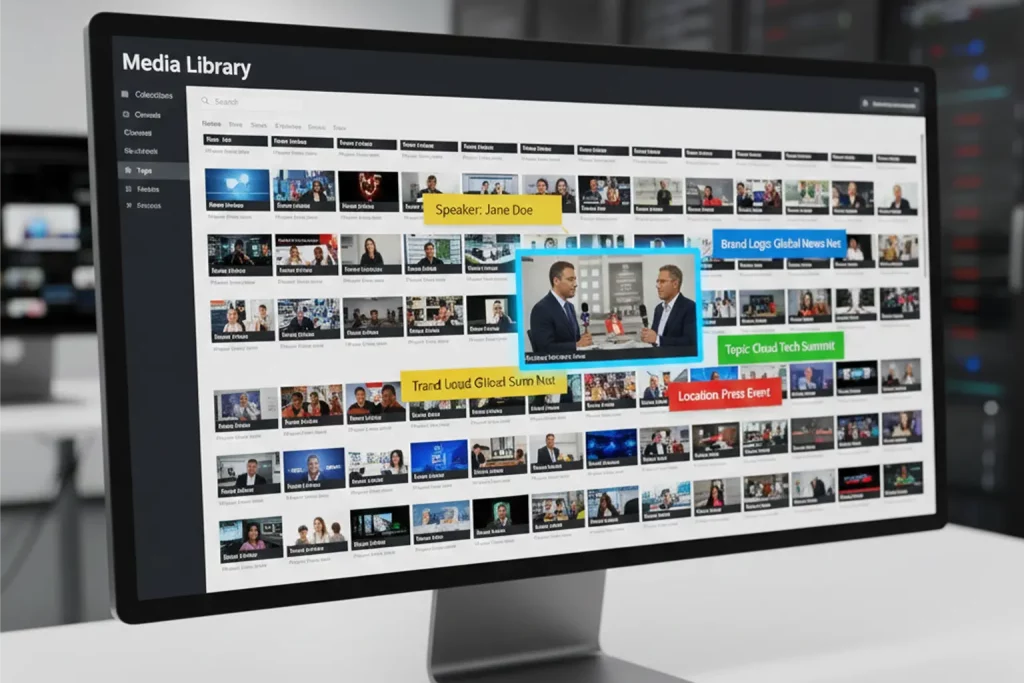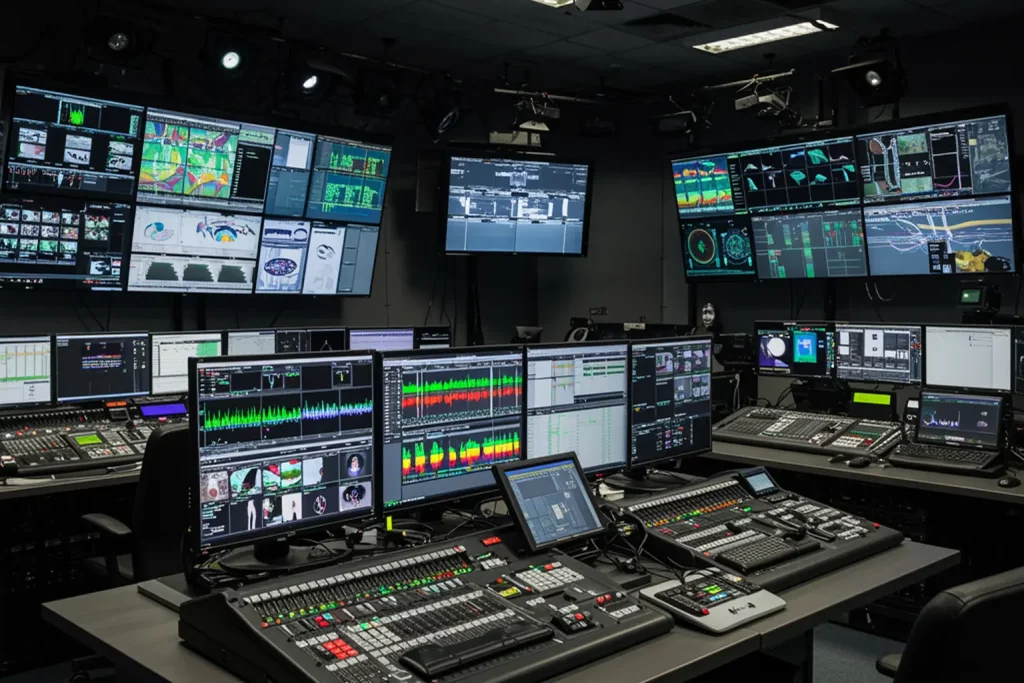Broadcasting is more than delivering content to viewers; it’s about doing so within a framework of laws, standards, and best practices. Broadcast compliance ensures content delivery meets regulatory standards, guaranteeing platform quality and legality. This article dives deep into the facets of broadcast compliance, covering key areas like loudness, SCTE, and metadata monitoring. Understanding these concepts is essential for broadcasters, producers, and tech professionals to stay compliant and avoid legal pitfalls.
What Is Broadcast Compliance?
Broadcast compliance refers to adhering to national and international regulations governing broadcasting standards. These rules ensure that audio-visual content delivered via TV, radio, and online platforms maintains consistent quality while staying within the legal bounds set by governing bodies.
Compliance touches every aspect of broadcasting, from maintaining proper loudness levels to ensuring that metadata is correctly transmitted. It ensures that viewers or listeners receive high-quality experiences without disruptions, offensive content, or technical issues.
For broadcasters, compliance isn’t just about following the law—it’s also about upholding the integrity of their brand and avoiding fines or sanctions from regulatory bodies like the Federal Communications Commission (FCC) in the U.S. or Ofcom in the U.K. As technology evolves and the demand for high-quality, reliable content increases, broadcast compliance becomes even more important.
FCC media regulatory compliance
While regulatory and compliance standards are designed to help organizations attain their business goals, some are intended to ensure data protection. When violated, laws or regulations applicable to any business process may invite legal punishments and federal fines. Regulatory violations can also tarnish a brand’s reputation. With changes made to regulations by legislative bodies on the rise, laws mandating the adherence to regulations have also become stringent.
Regulations vary from industry to industry, which explains why some industries are more heavily regulated than the others. Regarding broadcasting, the Federal Communications Commission or the FCC, a federal agency of Congress, is the regulatory body.
The broadcast law pertains to services related to both radio and television and checks for technical parameters and content issues, such as irreverence, copyright issues, and political and social ideologies like localism and regionalism.
Simplify Broadcast Compliance with Digital Nirvana’s MonitorIQ
At Digital Nirvana, we understand that managing broadcast compliance can be daunting, especially with the industry’s evolving regulations and standards. We developed MonitorIQ, our all-in-one solution for broadcast signal monitoring and compliance logging. Designed to keep broadcasters ahead of the curve, MonitorIQ provides the tools necessary to maintain compliance seamlessly and efficiently.
MonitorIQ 6.0 from Digital Nirvana is a trusted, next-generation compliance logging platform that complies with government and quality standards, such as loudness monitoring and compliance checks. It can also automatically monitor the presence, quality, and compliance of closed captions, subtitles, and Teletext.
Choosing Digital Nirvana means selecting a partner who prioritizes your peace of mind and offers a comprehensive approach that simplifies the complexities of broadcast compliance.
Loudness Monitoring
Loudness monitoring is a critical component of broadcast compliance. Viewers and listeners have likely experienced the frustration of loud commercials or inconsistent audio levels across different channels. To address this issue, loudness regulations were established.
One key regulation in this area is the Commercial Advertisement Loudness Mitigation Act (CALM Act), which the FCC introduced in 2010. The CALM Act mandates that commercials cannot be louder than their accompanying programs. This ensures a smooth audio experience for viewers and protects broadcasters from violating compliance standards.
How Loudness Monitoring Works
Loudness monitoring systems continuously measure audio levels in real-time, ensuring compliance with preset loudness thresholds. These systems allow broadcasters to automatically adjust the volume, providing consistent sound quality throughout programming and advertisements.
Beyond avoiding penalties, loudness monitoring enhances the viewer experience, helping broadcasters retain audiences by providing high-quality, consistent sound.
SCTE Monitoring
SCTE (Society of Cable Telecommunications Engineers) monitoring plays a significant role in maintaining compliance within broadcast systems. SCTE standards provide guidelines for inserting ad markers, signaling content changes, and more within cable and broadband video distribution networks.
Ad insertions, one of the most commonly monitored elements under SCTE, allow cable operators to switch in local ads dynamically, ensuring that ads are timed perfectly with the content. However, errors in this process can result in unsynchronized content or dead air, leading to regulatory violations.
SCTE Standards in Practice
SCTE 35 and SCTE 104 are two of the most common standards used in broadcast compliance. SCTE 35 deals with signaling markers that define when and where to insert ads or cue content changes. SCTE 104, on the other hand, focuses on metadata standards used for programming distribution.
Effective SCTE monitoring is essential for broadcasters to ensure that content switching and ad insertions happen without glitches. This guarantees a seamless experience for the audience while keeping broadcasters compliant with regulations.
Metadata Monitoring
In broadcasting, metadata ensures that content reaches the right audience with all the necessary information intact. Metadata refers to the essential data associated with media files, such as program titles, episode numbers, timestamps, and closed captions.
Metadata also includes rights management information, which ensures that content is distributed only to those who are licensed to view it. Incorrect metadata can cause problems such as unauthorized content distribution, leading to compliance violations.
The Importance of Accurate Metadata
Accurate metadata ensures broadcast content is categorized correctly, appropriately distributed, and accessible to all viewers. With the growing reliance on digital platforms, correct metadata ensures compatibility across various devices, from smart TVs to mobile phones.
Monitoring metadata means checking for discrepancies in this essential data and correcting errors before they become broadcast issues. For example, if closed captions are missing or incorrect, broadcasters could face fines or complaints from regulatory bodies.
For broadcasters, metadata monitoring tools are essential to their compliance toolkit, ensuring that everything from rights information to language preferences complies with industry standards and legal requirements.
What Laws Govern Broadcast Compliance?
Broadcast compliance laws vary by geographic location, but a few significant regulations apply internationally. The FCC oversees broadcasting regulations in the U.S., while Ofcom serves a similar role in the U.K. Other countries have regulatory bodies, all establishing guidelines broadcasters must follow.
Some critical laws related to broadcast compliance include:
- The Communications Act of 1934 (U.S.) is the cornerstone of U.S. broadcast regulation, mandating everything from decency standards to emergency broadcast protocols.
- CALM Act (U.S.): As mentioned earlier, this law regulates loudness levels for advertisements, ensuring that commercials are not louder than the programs they accompany.
- Children’s Television Act (U.S.): This act limits the amount of commercial content in children’s programming and mandates educational programming for younger viewers.
- Broadcasting Act of 1996 (U.K.) governs both public and commercial television, focusing on maintaining quality standards and protecting viewers from offensive or harmful content.
- European Audiovisual Media Services Directive: This regulation provides a framework for media services across Europe, including advertising standards, quotas for European content, and rules for on-demand services.
Compliance with these laws protects broadcasters from fines and helps maintain public trust. As content delivery methods evolve, these regulations adapt, ensuring broadcasters can operate efficiently while protecting their audiences.
How to Ensure Broadcast Compliance
Ensuring broadcast compliance requires a combination of technology, monitoring, and training. With advancements in broadcast technology, various tools are now available that can help broadcasters stay compliant with minimal manual effort.
- Automated Monitoring Tools: Many broadcasters rely on computerized systems to monitor loudness levels, metadata accuracy, and ad insertions. These tools are essential for tracking multiple streams of content in real time.
- Training Staff: It is key to ensure that all employees are trained on the latest regulations. This includes educating staff on how to use compliance tools and handle situations that may arise, such as viewer complaints or technical issues.
- Legal Consultation: Staying current on the latest regulations is a moving target. Having legal experts who specialize in broadcast compliance can help broadcasters avoid unintentional violations.
Conclusion
Broadcast compliance is critical to delivering high-quality content across various platforms. From loudness monitoring to metadata accuracy, ensuring that all technical and legal standards are met protects both the broadcaster and the viewer. By staying current on regulations, using automated monitoring tools, and ensuring thorough staff training, broadcasters can maintain compliance while providing top-notch content.
If you’re a broadcaster looking to optimize your compliance processes or ensure you adhere to the latest regulations, now is the time to invest in the right tools and training. Staying compliant protects you from fines and ensures you deliver the best possible experience to your audience.
Digital Nirvana: Empowering Knowledge Through Technology
Digital Nirvana stands at the forefront of the digital age, offering cutting-edge knowledge management solutions and business process automation.
Key Highlights of Digital Nirvana –
- Knowledge Management Solutions: Tailored to enhance organizational efficiency and insight discovery.
- Business Process Automation: Streamline operations with our sophisticated automation tools.
- AI-Based Workflows: Leverage the power of AI to optimize content creation and data analysis.
- Machine Learning & NLP: Our algorithms improve workflows and processes through continuous learning.
- Global Reliability: Trusted worldwide for improving scale, ensuring compliance, and reducing costs.
Book a free demo to scale up your content moderation, metadata, and indexing strategy for your media assets with minimal effort and get a firsthand experience of Digital Nirvana’s services.
Frequently Asked Questions
Q1: What happens if a broadcaster violates compliance regulations?
A1: Broadcasters who violate compliance regulations may face fines, suspension of their broadcasting license, or other legal actions. These penalties can vary based on the severity of the violation and the specific regulation involved.
Q2: How is loudness monitored in broadcasting?
A2: Loudness is monitored using automated systems that continuously track audio levels. These systems ensure that commercials and programs meet regulatory loudness standards, avoiding jarring audio changes for viewers.
Q3: What is SCTE 35, and why is it important?
A3: SCTE 35 is a standard that defines signaling markers for ad insertions and content switching in broadcast systems. It ensures that ad breaks are timed perfectly, maintaining a seamless viewing experience.
Q4: What role does metadata play in broadcasting?
A4: Metadata ensures content is categorized correctly, distributed, and accessible. It includes essential data such as program titles, closed captions, and rights management, which are crucial for maintaining broadcast compliance.
Q5: Are there different compliance rules for online broadcasts?
A5: Yes, online broadcasts often follow different regulations than traditional TV or radio. However, many rules, such as those related to loudness and metadata, still apply to online streaming platforms.




